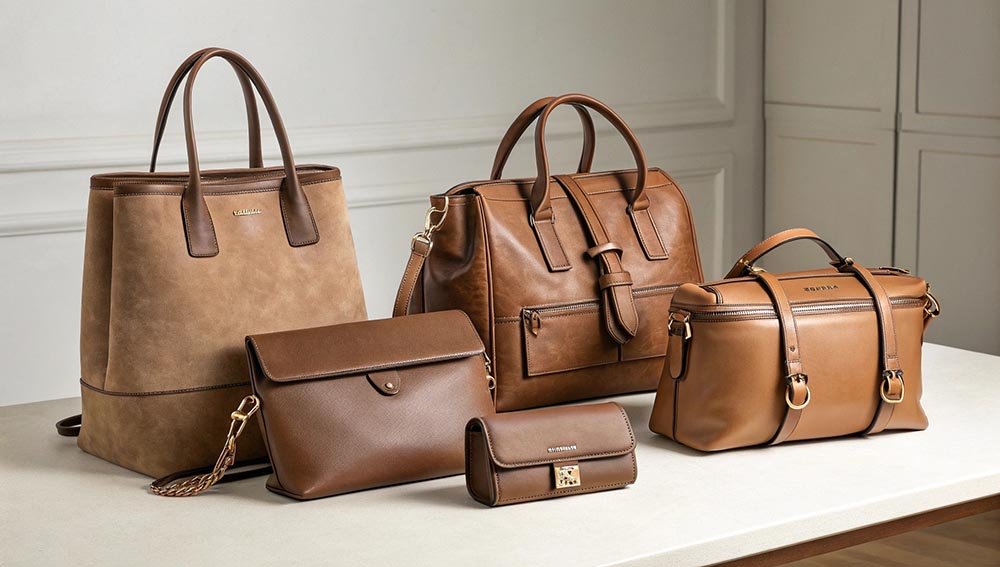Need a bag that is strong, stylish, and reflects your brand’s quality? Leather is expensive. Canvas can be plain. Denim bags offer a unique, durable option for your brand.
Denim bags are a popular B2B choice. They are durable, stylish, and highly customizable for branding. But they also have drawbacks. They can fade, absorb water, and may be too casual for certain corporate settings. Knowing these points helps you make a wise investment.

Denim is a classic material. It is used for more than just jeans. As a business owner or buyer, understanding the fabric helps you understand the product. Let’s look closer at what denim really is.
What is denim fabric?
You see "denim" everywhere. But do you know what makes it different from simple cotton canvas? This special weave makes it a strong foundation for your brand’s bags.
Denim is a strong cotton fabric. It uses a twill weave. This creates a diagonal pattern you can see up close. It is durable, thick, and breathable. This fabric is used for jeans, jackets, and popular styles like the denim tote bag or hobo denim bag.

Denim’s strength comes from its twill weave1. This weave uses one colored thread (usually blue) and one white thread. The blue thread passes over two or more white threads. This is why the inside of your jeans is often lighter than the outside. This structure makes the fabric very tough and resistant to tearing2. It is a true workhorse material.
Key Fabric Features
Denim is not just strong. It has other useful features. It is quite thick, so it protects the items inside. It is also breathable because it is made from cotton. This prevents moisture from building up.
From my experience, the best part is how it ages. The fabric softens with use but keeps its core shape. The color fades in a unique way. This gives each bag a premium, authentic look. This unique fading3 is a design feature, not a flaw.
What Are the Advantages of Denim Bags?
Businesses need bags that last and look good. Cheap materials tear and reflect poorly on your brand. Boring materials do not get noticed. Denim bags solve both problems.
Denim bags have many benefits. They are extremely durable and resist abrasion. They offer a classic, casual look that pairs with many styles. Denim is also easy to customize for branding, and it is simpler to clean than materials like leather.

The biggest advantage is durability. This is key for B2B. You want your brand on a bag that lasts. This reflects the quality of your own business. The twill cotton fabric is built for daily wear. It resists rubbing, tearing, and abrasion. This strength also means it can carry heavy items without stress.
A Unique, Aging Character
This is my favorite aspect of denim. Unlike other fabrics that look "old" or "damaged," denim develops character. As I’ve seen with my products, denim gets softer with use, but it holds its shape. A little fading adds to its unique design story. This "broken-in" look is something end-users actually value, which increases the bag’s long-term appeal.
Versatility in Style and Customization
Denim is timelessly fashionable. It has a casual, cool look that fits almost any relaxed brand image. The style options are also very diverse. You can find everything from a classic denim tote bag e large denim bag to a casual hobo denim bag o un small denim bag.
This fabric is a powerful canvas for branding.
- Printing: Screen printing or digital printing looks bold and clear.
- Embroidery: Stitching a logo adds a premium, textured feel.
- Washes: You are not limited to one color. Acid wash, light wash, or dark indigo wash can completely change the bag’s personality.
- Patches: Adding a custom leather, PVC, or woven patch creates a sophisticated, high-end touch.
Maintenance and Sustainability
Denim is a practical choice. Compared to leather, it is much easier to care for. This is a great benefit for the end-user, which reflects well on your brand. Finally, denim can be a great eco-friendly story. Many suppliers offer recycled denim. And because the bags are so durable, they last for years. This longevity means less waste.
What Are the Drawbacks of Denim Bags?
Denim seems like a perfect material. But it can be ruined by a simple rain shower or a coffee spill. You must know the weaknesses before you invest.
Denim bags are not perfect. Their biggest drawback is low water resistance. They absorb water quickly. Dark, raw denim can also fade or transfer color when wet. They can also be heavy, and the casual look is not suitable for all formal business settings.

You must consider a few problems. Water is the main issue. Denim is cotton, so it absorbs moisture easily. This is a significant risk if your end-users carry laptops or paper documents. A sudden rain shower can soak the bag and everything inside. The bag also becomes heavy and very slow to dry.
Color Fading and Transfer
This is a major risk. New, dark "raw" denim can transfer dye. This is called "crocking." The blue dye can rub off onto an end-user’s light-colored shirt. This can create a negative brand experience. Over time, sunlight and washing will also cause the color to fade. This is a problem if you need the bag to match an exact brand color.
Weight and Shape Issues
Denim is a heavy fabric. A large denim bag will be noticeably heavier than a nylon or polyester bag prima you even put anything in it. While the fabric is strong, it is also soft. If a user constantly carries heavy, bulky items (like textbooks or a large laptop), the bag may sag and lose its original sharp shape over time.
The "Too Casual" Problem
Finally, the look is very specific. Denim is casual. It is perfect for a creative brand, a coffee shop, or a relaxed startup. It is not the right choice for a law firm, a bank, or a formal corporate conference. In those settings, a denim bag can look unprofessional.
How to Choose the Right Style of Denim Bag?
You want a denim bag for your business. But there are so many options. Totes, hobos, light wash, dark wash. Matching the bag to your end-user’s needs is the key.
To choose the right denim bag, first think about its purpose. A denim tote bag is practical for work or shopping. A crossbody denim bag is for casual outings. Also, consider the fabric’s wash, your brand’s style, and functional needs like zippers.

Finding the perfect denim bag means thinking about the end-user. How will your customer use this bag?
Match the Bag to the Purpose
- Denim Tote Bag: This is the most versatile option. It is great for trade show giveaways, bookstore merchandise, or a sturdy company bag for employees. Its large, open space is practical for carrying laptops, notebooks, or shopping.
- Crossbody & Hobo Bags: These are for lifestyle brands. They are perfect for customers who need to be hands-free. Think about music festivals, casual weekend outings, or as a stylish travel bag. The focus here is on comfort and style.
- Large Denim Bag: This is for travel or specialty needs. Use this for a weekend getaway bag, a gym bag, or a durable beach bag. The extra space is the main selling point, but remember it can get heavy.
- Small Denim Bag: This is a great accessory item. Think of a branded cosmetic pouch, a pencil case for a creative agency, or a small clutch. It works well as a gift-with-purchase to complement a larger product.
Consider the Material and Style
The denim itself matters. A dark, stiff, "raw" denim looks cleaner and more professional. A light-wash, soft denim feels very casual, relaxed, and summery. Your brand’s style should guide this choice. A retro or street-style brand might prefer a faded, "worn-in" look. A minimalist brand might want a clean, dark indigo.
Focus on Functional Details
These small things make a big difference in quality.
- Zippers: An open-top tote is common for giveaways. But a zipper closure adds security and value, making it a better bag for travel or commuting.
- Pockets & Compartments: Does the user need to stay organized? An inner pocket for a phone, or a separate sleeve for a laptop, makes the bag much more practical for daily use. More features often mean a higher perceived value.
How to Care for Denim Bags to Keep Them Looking New?
Your customers love their new denim bag. But they worry that one wash will ruin it. Proper care instructions are simple and protect the bag (and your brand image).
To care for a denim bag, advise users to wash it as little as possible. Spot-clean small stains with a damp cloth. If a full wash is needed, use cold water and a gentle cycle, or hand wash. Always air dry away from direct sun.

Denim bags are strong, but they need some care to last. As a supplier, I always give this advice. The most important rule: wash it rarely. Washing breaks down the fibers and fades the color. Reducing the wash frequency is the best way to extend the life of the bag. This also saves water.
Cleaning and Drying
For dust, just wipe it with a dry cloth. For small spills, "spot-clean" the area. Use a damp cloth, maybe with a tiny bit of gentle soap. Rub gently.
If the whole bag is very dirty, here is how to wash a denim bag:
Hand Wash: This is safest. Turn the bag inside out. Wash it in cold water.
Machine Wash: Turn it inside out. Put it in a mesh laundry bag. Use the cold, gentle cycle.
Never use a hot dryer. The heat will shrink it. Reshape the bag and let it air dry. Keep it out of direct sunlight. Sun will fade the color fast. Providing these simple tips can increase customer satisfaction with the product.
Conclusione
Denim bags are a solid investment. They are durable, stylish, and full of character. They are a fantastic, eco-friendly option for a brand that wants to stand out.
Frequently Asked Questions
Q: What is the main difference between a denim bag and a canvas bag?
A: Both are strong cotton. But denim uses a twill weave, which gives it a diagonal texture, a softer feel, and a "fashion" look that ages with character. Canvas uses a plain weave, making it stiffer, lighter, and more uniform in appearance.
Q: Will my denim bag shrink if I wash it?
A: It can shrink if you use hot water or a hot machine dryer. This is why we always recommend washing only when necessary, using cold water, and always letting it air dry.
Q: How can I stop a new dark denim bag from transferring color to my clothes?
A: This is a risk with new, dark "raw" denim. You can try a pre-soak in cold water with a cup of white vinegar to help set the dye. But the safest option is to choose "washed denim," which has already been processed.
Q: Are denim bags waterproof?
A: No, denim bags are not waterproof. They are made of cotton and will absorb water quickly, just like a pair of jeans. They are not recommended for use as a primary rain bag.
Q: Are denim bags considered professional for work?
A: It depends on the workplace. For a creative agency, design studio, or casual office, a clean, dark denim tote is very stylish. For a formal corporate setting like a bank or law firm, it is usually considered too casual.
Q: How is recycled denim different from regular denim?
A: Recycled denim is made by shredding old jeans (post-consumer waste) and re-spinning the fibers into new yarn. It has the same great look but uses far less water and energy, making it a much more sustainable B2B option.
Q: Is it hard to print a colorful logo on a dark blue denim bag?
A: It’s not difficult, but it requires a special technique. To make sure the colors are bright, we first print a white "underbase" layer and then print your color logo on top. This stops the dark blue from dulling your brand’s colors.
Q: Why are some denim bags stiff and others very soft?
A: This depends on the "wash." A stiff bag is likely "raw denim," which has not been washed after dyeing. A soft bag has been "stone-washed" or "enzyme-washed" to break down the fabric, making it softer and lighter in color.
Q: Can a denim bag hold a heavy laptop safely?
A: The fabric itself is strong enough. However, you should look for a bag specifically designed for it. This means a bag with a padded internal sleeve and, most importantly, reinforced stitching on the straps to handle the focused weight.
Q: Are denim bags a good eco-friendly choice?
A: They can be. A well-made denim bag is very durable and will last for many years, which reduces waste. For the best eco-friendly option, choose bags made from recycled denim o cotone biologico, as this saves a large amount of water.




